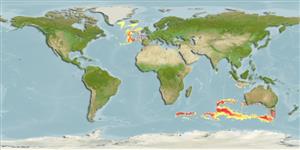>
Gadiformes (Cods) >
Macrouridae (Grenadiers or rattails)
Etymology: Asthenomacrurus: Greek, asthenia = weakness + Greek, makros = great + Greek, oura = tail (Ref. 45335); victoris: Named for Viktor Markelovich Makushek..
Environment: milieu / climate zone / depth range / distribution range
Ökologie
seewasser bathydemersal; tiefenbereich 2320 - 3530 m (Ref. 41160). Deep-water
Indo-West Pacific: Naturaliste Plateau, off southwestern Australia (Ref. 7300). Near the base of the Arabian Indian ridge and off the east coast of Honshu Island (Ref. 41160). North Atlantic: Mid-Atlantic Ridge (Ref. 75229).
Size / Gewicht / Alter
Maturity: Lm ? range ? - ? cm
Max length : 24.9 cm TL Männchen/unbestimmt; (Ref. 41160)
Probably belongs to the upper abyssal area (Ref. 41160). Benthic (Ref. 75154).
Life cycle and mating behavior
Maturities | Fortpflanzung | Spawnings | Egg(s) | Fecundities | Larven
Sazonov, Y.I. and Y.N. Shcherbachev, 1982. A preliminary review of grenadiers related to the genus Cetonurus Günther (Gadiformes, Macrouridae). Descriptions of new taxa related to the genera Cetonurus Günther and Kumba Marshall. J. Ichthyol. 22(5):1-15. (Ref. 41160)
IUCN Rote Liste Status (Ref. 130435)
Bedrohung für Menschen
Harmless
Nutzung durch Menschen
Tools
Zusatzinformationen
Download XML
Internet Quellen
Estimates based on models
Preferred temperature (Ref.
123201): 1.2 - 2, mean 2 °C (based on 45 cells).
Phylogenetic diversity index (Ref.
82804): PD
50 = 0.7500 [Uniqueness, from 0.5 = low to 2.0 = high].
Bayesian length-weight: a=0.00575 (0.00195 - 0.01700), b=3.08 (2.83 - 3.33), in cm total length, based on LWR estimates for this (Sub)family-body shape (Ref.
93245).
Trophic level (Ref.
69278): 3.5 ±0.5 se; based on size and trophs of closest relatives
Widerstandsfähigkeit (Ref.
120179): mittel, Verdopplung der Population dauert 1,4 - 4,4 Jahre. (Preliminary K or Fecundity.).
Fishing Vulnerability (Ref.
59153): Low vulnerability (15 of 100).
